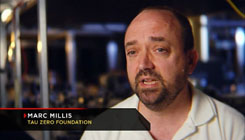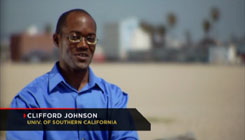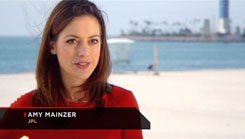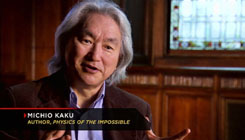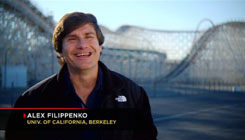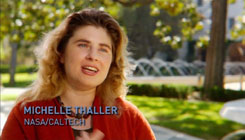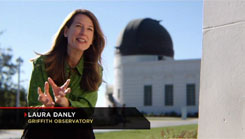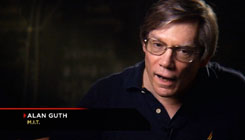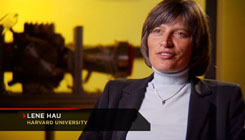Light Speed
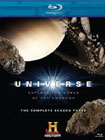 |
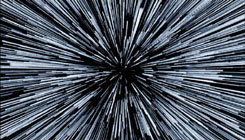 |
The Universe
Season 3
12 episodes
|
See below for purchasing options
DVD & Blu-ray
|
|
"The Universe" episode no. 35 (season 3)
- written and directed by Darryl Rehr
- produced by Arthur Maturo
- edited by Tom Ronca
- narrated by Erik Thompson
- Main Title Theme and Original Music by Eric Amdahl
- Flight 33 Productions, (c) 2008 A & E TV Networks
- 1 documentary @ 44 minutes
|
In-depth Review
|
|
by Martin Izsak
|
This episode's valiant attempt to address many aspects
of physics, relativity, and the speed of light results in the
unearthing of some fascinating bits of information and some
classic sequences clarifying some concepts. But it also misses
a few tricks, some of which I consider SO important, that they
can change our fundamental view of the subject matter.
How would we know if we were traveling at PRECISELY
70% of the speed of light? Against what would we measure
our own speed? Answering that question requires that we
examine and maintain clarity about our "frames of reference".
This episode joins a pantheon of documentaries, books,
professional scientists, and teaching aids that
end up implying a single absolute frame of reference,
allowing its audience to miss Albert Einstein's central point entirely.
When we remain determined to boil out an answer of how to
measure our "approach to the speed of light",
and we're careful to remember the various frames of reference involved
when there are multiple observers traveling at different speeds,
that answer becomes truly more fascinating and freeing than this
documentary would have you believe:
The constancy of the speed of light
is anchored relative to the observer's eyeball.
Roemer's Timelag
The first segment is primarily concerned with defining
the speed numerically, and making an excellent and extensive
presentation of all the ways in which
Ole Roemer's Lightspeed Timelag affects
astronomers and space communications over greater and
greater distances. Missing is any actual mention
of Ole Roemer, or his success in making Mankind's
first successful calculation of the speed of light
by observing Jupiter's moons in the late 1600's.
Only in writer/director Darryl Rehr's excellent episode "Nebulas"
from the previous season do we get the concept that
visible light is only a tiny fraction of the entire spectrum
of electromagnetic radiation. It is in fact that entire spectrum
that travels at the "speed of light". Many non-Americans like me
have no use or affinity for measurements in miles, so a bit
of expansion on the documentary can gives us these values:
Light speed = 186 000 miles per second (American)
Light speed = 300 000 kilometers per second (World)
or more precisely 299 792.458 kilometers per second
1 Light Year (LY) = 6,000,000,000,000 miles (American)
That's 6 trillion miles.
This early segment scores good points detailing the distance
light, radio signals, and other electromagnetic waves travel
in one second, and their travel time from the Earth to the moon, from the sun to the Earth,
and from the Earth to various unmanned probes
we've launched into the outer solar system. This travel time of light is expanded
to various observable objects, from nearby stars to distant galaxies, such that the farther we look
the further back in time the image was created. After about 13.5 billion light years,
we've reached the limit of the known age of the universe.
Laura Danly shows some photos of Galaxy A1689-zD1 - one of the furthest objects known.
We see it as it was billions of years ago, shortly after it formed from the big bang.
It seems odd that Alex Filippenko attempts to explain
the Doppler Red Shift
by unnecessarily roping in the stretching of space.
You can have Doppler Red Shift with or without Relativity
and astronomers have both ways of calculating Red Shift
at their disposal.
Sound definitely prefers to go without Relativity
for its Doppler pitch shift.
Cosmos episode 10
handles the Doppler Shift concept more cleanly
and with better detail, but the brevity of the presentation here
seems to quickly blast through
Edwin Hubble's discovery of the expansion of the universe
as a set-up for the very cool 13 billion LY "light horizon" concept,
which is a fascinating way to go, and has some excellent graphics
demonstrating that beyond these perceptual limits, there may be something more....
I often think of similar thought-provoking graphics defining not distance
but speed, as a set of observers each traveling at nearly the speed of light
relative to his nearest neighbour, extends common conceptions of what is
physically possible.
We get a good look at the Hubble Space Telescope's ultra-deep field. Also examined are
contradictions between the big bang theory and the uniformity of the known universe's
background radiation, which makes Amy Mainzer want to mix blue and yellow paint in the
paint store.
|
Participants include:
|
Speed Becomes Relative...
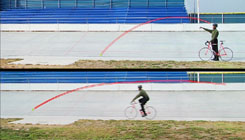
|
The third segment features Clifford Johnson's cycling extravaganza,
as he helps us tackle concepts like light's speed relative to bodies in motion,
and time/space dilation effects.
Unfortunately, this is the segment that gets into real trouble,
the one that could benefit most from a "frame of reference" debunking
- if, of course,
that debunking was more thorough than what most professional scientists usually seem to manage.
I'll give the documentary kudos on the bit with
the tennis ball making regular momentum clear.
Most of Johnson's biking wonkiness and the accompanying visual effects
seem to be a direct descendant of Carl Sagan's motor-scootering from
Cosmos episode 8,
only thankfully minus the same level of irritating bossiness.
So, additional kudos on the improvement on the tone
of the explanations here.
|
But we still end up tackling light speed through the back door,
examining it relative to its source. Yes, the source's motion
is completely independent. This leads
to mathematical redefinitions of momentum, and by extension
redefinition of a lot of the rest of physics.
Yep, great. But the episode fails to "go through the front door"
and ask the really interesting question:
Is light speed independent of the observer's motion?
Apparently not - Light speed is actually anchored relative
to the observer's motion! Incredible! How does that even work?
No matter how fast an observer travels, he observes
light to be traveling 300,000 km/s faster than himself,
from all directions towards his eyeball.
With that in mind, any observer would be truly hard pressed to know
when, or if, he had managed to "achieve a speed of 70% of the speed of light".
In fact, the phrase doesn't even make sense in relativity
until you specify which observer that 70% of light speed is relative to.
When the traveler is the observer,
and the center of the Earth's solar system is receding from the
aft viewport of his spaceship at 70% of the speed of light,
in his own frame of reference he is calculated to be at rest,
with a velocity of 0, and the speed of light would appear to be yet
another 299 792 km/s beyond him.
Just as with the Principle of Relativity, where no one can claim to know
which frame of reference is REALLY at rest and which is moving, neither
can any one claim to know which frame of reference is REALLY traveling
close to the speed of light and which isn't. The speed of light
continues to remain 299 792 steps ahead of anyone who looks.
The Emperor's New GPS Proof
Alex Filippenko brings GPS calculations into the mix
as proof of Relativity. We should note, however, that
General Relativity requires us to consider two factors
WHICH CANCEL EACH OTHER OUT and give essentially the same
answer we would have got under Newton's laws. Just how common is it,
that whenever GPS is used as proof of Relativity, we hear one
of these factors mentioned but not the other?
Here in this episode, we get the
factor of the satellite's faster motion slowing its clock down.
Conveniently left out is the concept of the clock on the
ground sitting "deeper" in the Earth's gravitational field,
which will slow it down by a complementary amount.
If this final number is precisely the same with and without
Relativity, neither of these factors has proven itself
relevant, important, or true... in THIS example from GPS.
Interestingly, the season two episode "Cosmic Holes"
saw Filippenko citing the opposite factor - gravity -
while conveniently leaving out the orbital speed of the satellite
as a counterbalance in GPS calculations. And so it seems important
to only talk about one of them but not the other if claiming that
they prove Relativity. How much more interesting and controversial
GPS becomes when we put both factors together....
You'll have to look beyond episodes of "The Universe" for this,
but it is actually quite fascinating to listen to the struggles
of GPS Engineer Ron Hatch with his colleagues as they argue over
all the different things that need to be done to make GPS more
accurate, and the varied way that many physicists challenge and
attempt to improve upon Relativity to the point where it might
actually work for them. GPS still throws many practical hurdles
at them which Relativity does not seem to be properly equipped to handle.
And when you look at it, how accurate is GPS so far, really?
The actual functioning of GPS is far more complicated than
anything we've managed to talk about here. There may indeed be
somewhere in it something else that requires General Relativity
in order to work correctly. But if so, you'd think that might
be the factor that gets mentioned, instead of the separate halves
of the Emperor's New Clothes here.
Slowing Down And Looking Deeper...
It is segments four and five that really bring out some unique angles
and concepts for approaching the subject of light speed. Sadly,
these are the shortest two segments of the program, and
really deserved to be expanded upon with at least twice as much
screen time.
The fourth segment opens up a huge caveat to light speed's constancy:
The speed of light changes depending
on the medium that it is traveling through. Glass slows light down to about 2/3
of its normal speed through a vacuum. Water also has a slowing effect.
Dr. Lene Hau is busy in a lab at Harvard slowing it down much further than that,
passing it through super-chilled clouds of sodium gas in a tightly controlled experiment....
Excellent stuff! In fact, this bit is now burned into my brain such that
anytime anyone babbles on about light speed being constant,
I automatically think of Hau and her work as a counterbalancing concept.
It makes one wonder... If light speed can slow down to almost zero,
have we really seen it at its fastest yet? Is 299 792 km/s really the right number?
Is it always the right number? Ron Hatch floated the notion that it is the correct
average number for the set of nested gravitational fields our Earth sits in,
but not necessarily for, say, Mars or Jupiter, or Alpha Centauri, or the Andromeda Galaxy.
Perhaps we'll know more when we actually get a Human eyeball and brain to some of those
locations, rather than robotic camera proxies.
The fifth segment teases us with a real coup by bringing out
Marc Millis who has the passion to challenge perceived taboos and barriers
to get us to the next star on time. Millis gets a few good soundbites into the program,
but this segment doesn't really go into his take on things deeply enough for my tastes.
The program sidelines itself to warp drive theory postponed for centuries before bowing out.
In the end there are a lot of nice bits in this episode, but it doesn't really
go deep enough with accepted theory of relativity or its proofs to make it convincing,
or carefully enough to avoid some common misconceptions about light speed.
What it perhaps does best is to whet our appetites for more,
and hint at a few avenues for looking into areas of
interest in greater depth. I will say I like it much better than
Cosmos episode 8,
since it seems open to a wider range of perspectives
on light speed and comes across with a more agreeable tone.
It can also help trigger good debate concerning Einstein's Theories
of Relativity and the speed of light, and it does bring some good information
to that debate quite memorably.
But its central oversight keeps it on a different level
from writer/director Darryl Rehr's many other excellent episodes
of "The Universe" which I enjoy so much more.
from the disc sleeve:
Light Speed:
It is the ultimate constant in the universe - incredibly fast from the human perspective,
yet agonizingly slow in the distance scales of space. Explore light speed and the phenomena
it enables, as well as the ways scientists envision breaking the "light barrier" - and
if doing so could make the interstellar travel of science fiction a reality.
Chapter List:
- Introduction
- Limits
- Measuring Distance
- Theory of Relativity
- Slowing Down Light Speed
- Star Travel
This documentary has become available on DVD and Blu-ray.
Click on the amazon symbol for your area to open amazon's page in a new window
and see additional product information before purchasing.

The Universe
Season 3 Box Set
12 episodes
|
U.S.


| Canada


| U.K.


|
Blu-ray U.S.


| Blu-ray Canada


| Blu-ray U.K.


|
Comments on this article are welcome. You may contact
the author from this page:
Contact page

LYRATEK.COM
|
Read the data capsule review for another episode:
"Alien Faces"

|
|


